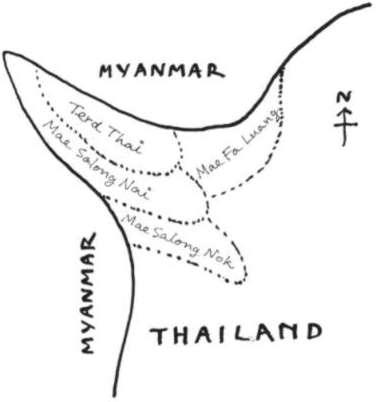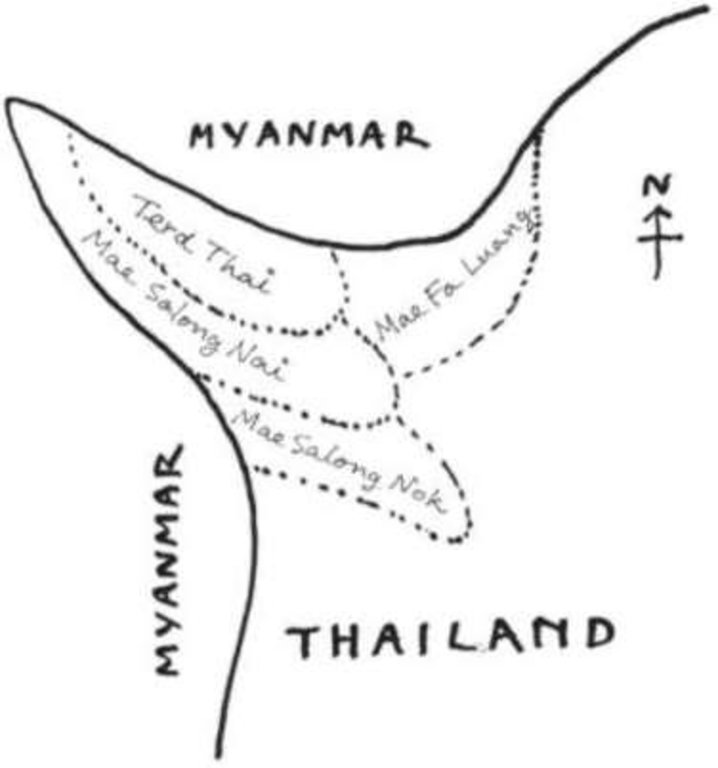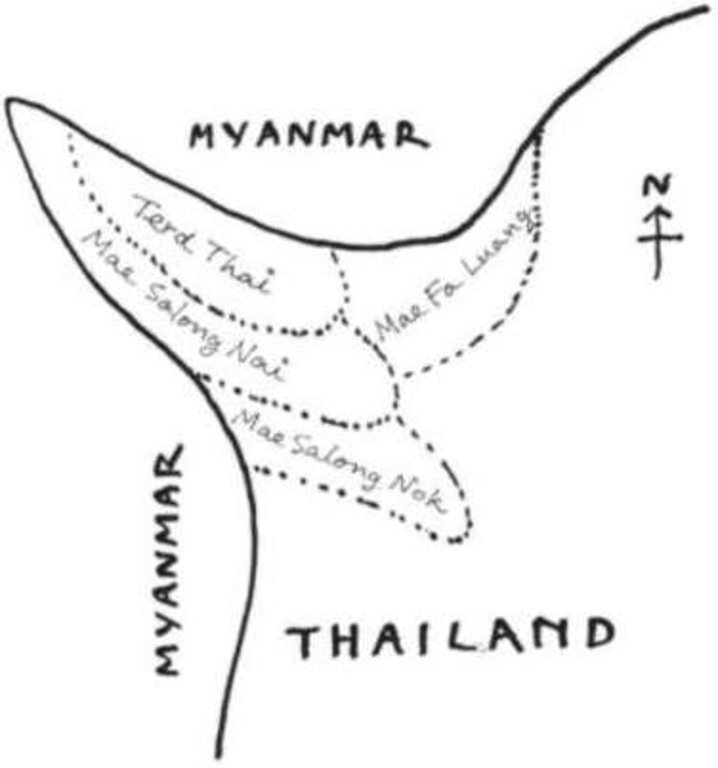Small bench terrace [Thailand]
- Creation:
- Update:
- Compiler: Philippe Zahner
- Editor: –
- Reviewer: Fabian Ottiger
approaches_2670 - Thailand
View sections
Expand all Collapse all1. General information
1.2 Contact details of resource persons and institutions involved in the assessment and documentation of the Approach
SLM specialist:
Cheewinkuntong Wichai
Wang Put Tan, Ban Santikiri, Amphur Mae Fa Luang, Chiang Rai 57110
Thailand
Name of the institution(s) which facilitated the documentation/ evaluation of the Approach (if relevant)
Swiss Agency for Development and Cooperation (DEZA / COSUDE / DDC / SDC) - Switzerland1.3 Conditions regarding the use of data documented through WOCAT
The compiler and key resource person(s) accept the conditions regarding the use of data documented through WOCAT:
Ja
2. Description of the SLM Approach
2.1 Short description of the Approach
This approach is 'the way' or 'how' the small bench terrace has been implemented on sloping land in northern Thailand.
2.2 Detailed description of the Approach
Detailed description of the Approach:
Aims / objectives: The small bench terrace is a kind of soil conservation measure constructed on sloping land. The main feature is that flat beds are constructed out of the land which is not level primarily to facilitate working in the field, but with benefit of conserving soil at the same time. Normally farmers will implement by themselves with their own fund. In few cases there can be some initiation from some organizations and some help will be provided. This approach has been imported from Taiwan from where some tea bushes were brought to grow in Chiang Rai Province.
2.3 Photos of the Approach
2.5 Country/ region/ locations where the Approach has been applied
Country:
Thailand
Region/ State/ Province:
Chiang Rai
Map
×2.7 Type of Approach
- traditional/ indigenous
2.8 Main aims/ objectives of the Approach
The Approach focused on SLM only
1. To facilitate cultivation of crops, 2. To ease working in the field, 3. To reduce soil erosion, 4. To increase crop yield.
The SLM Approach addressed the following problems: Steepland in the North, where rainfall is high, has been brought to cultivation. There apparently was a sign of excessive runoff from the land, farmers therefore constructed the small bench terrace, the idea of which was brought from Taiwan.
2.9 Conditions enabling or hindering implementation of the Technology/ Technologies applied under the Approach
availability/ access to financial resources and services
- hindering
To construct the small bench terrace it costs money. Poor farmers cannot afford.
Treatment through the SLM Approach: There is no treatment at present. Farmers may need to borrow money to do it.
3. Participation and roles of stakeholders involved
3.1 Stakeholders involved in the Approach and their roles
- local land users/ local communities
Specific ethnic groups: E-kaw, Lahu, Lisu, Mien, Khin, Thai Yai, Haw Chinese, H'mong
Farmers do it by themselves. Farmers feel it is necessary to construct the small bench terrace to facilitate crop cultivation and working conditions so they do it despite their poverty.
3.2 Involvement of local land users/ local communities in the different phases of the Approach
| Involvement of local land users/ local communities | Specify who was involved and describe activities | |
|---|---|---|
| initiation/ motivation | none | |
| planning | none | |
| implementation | none | responsibility for major steps |
| monitoring/ evaluation | none | |
| Research | none |
3.4 Decision-making on the selection of SLM Technology/ Technologies
Specify who decided on the selection of the Technology/ Technologies to be implemented:
- land users alone (self-initiative)
Explain:
land user driven (bottom-up). Farmers will see that by having SWC technology in their farm, they will have a better return from crop production. Some farmers may also understand that their soil resources will be better protected and remain fertile for a long time.
Decisions on the method of implementing the SLM Technology were made by by land users* alone (self-initiative / bottom-up). land user driven (bottom-up). Farmers decide about the method of implementing SWC technology by considering their available resources, topography of their farm and the return from the investment.
4. Technical support, capacity building, and knowledge management
4.2 Advisory service
Do land users have access to an advisory service?
Ja
Specify whether advisory service is provided:
- on land users' fields
- Farmer to farmer
Describe/ comments:
Name of method used for advisory service: Farmer to farmer; Key elements: Simplicity, Low cost, Functionality
4.3 Institution strengthening (organizational development)
Have institutions been established or strengthened through the Approach?
- no
5. Financing and external material support
5.1 Annual budget for the SLM component of the Approach
Comments (e.g. main sources of funding/ major donors):
Approach costs were met by the following donors: other (Personal fund): 100.0%
5.2 Financial/ material support provided to land users
Did land users receive financial/ material support for implementing the Technology/ Technologies?
Nee
5.3 Subsidies for specific inputs (including labour)
If labour by land users was a substantial input, was it:
- voluntary
Comments:
They do it by themselves through the technology brought from Taiwan.
5.4 Credit
Was credit provided under the Approach for SLM activities?
Nee
6. Impact analysis and concluding statements
6.1 Impacts of the Approach
Did the Approach help land users to implement and maintain SLM Technologies?
- No
- Yes, little
- Yes, moderately
- Yes, greatly
Construction of the small bench terrace
Did other land users / projects adopt the Approach?
- No
- Yes, little
- Yes, moderately
- Yes, greatly
It is being used by farmers in other areas too, but probably not to a wide extent.
6.3 Sustainability of Approach activities
Can the land users sustain what has been implemented through the Approach (without external support)?
- yes
6.4 Strengths/ advantages of the Approach
| Strengths/ advantages/ opportunities in the land user’s view |
|---|
| Easy to do the farm work. |
| Can obtain relatively high yield. |
| Soil fertility is improved. |
| Strengths/ advantages/ opportunities in the compiler’s or other key resource person’s view |
|---|
| Reduce soil loss in large areas grown to horticultural crops and bush-type crops (How to sustain/ enhance this strength: Inspect the field during/after rain to see how efficient they are in SWC & repair as necessary.) |
| Easy to improve soil fertility, whereby the crop yield is sustained |
| Easy to do the work in the farm. |
6.5 Weaknesses/ disadvantages of the Approach and ways of overcoming them
| Weaknesses/ disadvantages/ risks in the land user’s view | How can they be overcome? |
|---|---|
| Have to pay for its construction | The government may help after some time. |
| Weaknesses/ disadvantages/ risks in the compiler’s or other key resource person’s view | How can they be overcome? |
|---|---|
| Water channels if not well planned may scour the land and gyullies may appear. | Plan the water channels well. |
| A part of the cropped area may be lost. | No way. |
7. References and links
7.1 Methods/ sources of information
- field visits, field surveys
- interviews with land users
Links and modules
Expand all Collapse allLinks
No links
Modules
No modules





